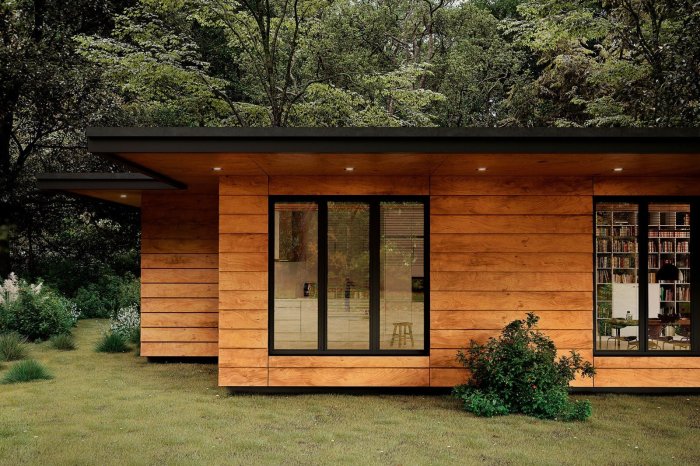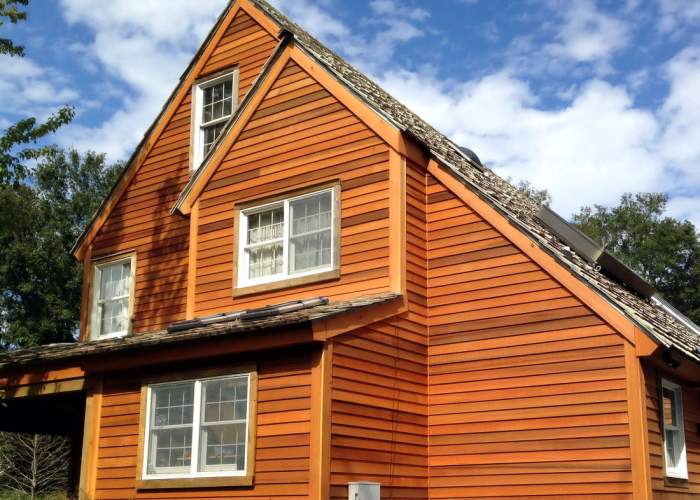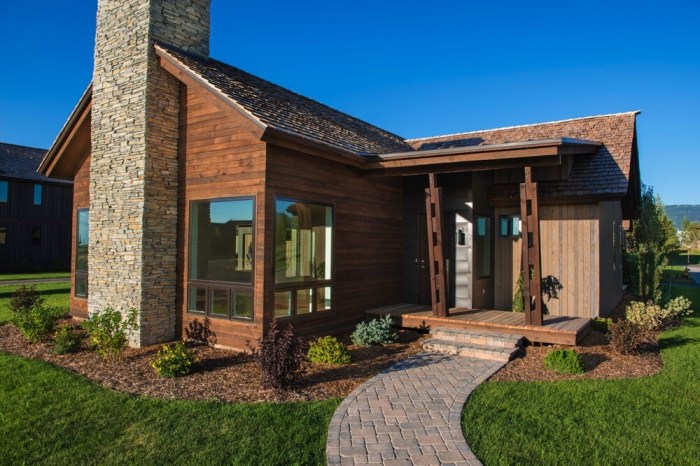Step into the world of natural wood siding houses, where elegance meets durability. This guide is your key to unlocking the beauty and benefits of incorporating natural wood into your home's exterior.
Delve into the descriptions of wood species, installation tips, design inspirations, and eco-friendly aspects that make natural wood siding a top choice for homeowners.
Natural Wood Siding House Overview

Natural wood siding is a popular choice for homeowners looking to add warmth and character to their homes. It is made from authentic wood materials and offers a unique aesthetic appeal.
There are several benefits to using natural wood siding for a house. One of the main advantages is its natural beauty and warmth that can enhance the overall appearance of a home. Wood siding also provides excellent insulation, helping to regulate indoor temperatures and reduce energy costs.
Additionally, natural wood is a sustainable and eco-friendly building material, making it a popular choice for environmentally conscious homeowners.
Popular Wood Species Used in Natural Wood Siding
- Cedar: Known for its natural resistance to decay and insects, cedar wood siding is durable and requires minimal maintenance.
- Pine: Pine wood siding is a cost-effective option that can be easily stained or painted to achieve the desired look.
- Redwood: Redwood siding is prized for its rich, reddish-brown color and natural resistance to rotting and warping.
- Cypress: Cypress wood siding is valued for its durability and natural resistance to decay, making it a popular choice for humid climates.
Installation and Maintenance

Installing natural wood siding on a house requires careful planning and precision to ensure a long-lasting and visually appealing result. The maintenance of natural wood siding is essential to preserve its beauty and protect it from the elements.
Installation Process
When installing natural wood siding, the first step is to prepare the surface by removing any existing siding and ensuring the walls are clean and dry. Next, the siding panels are carefully measured and cut to fit the dimensions of the house.
It is important to leave a small gap between each panel to allow for expansion and contraction due to changes in temperature and humidity.
- Apply a weather-resistant barrier, such as house wrap, to the walls before attaching the siding panels.
- Secure the panels to the walls using nails or screws, making sure to follow the manufacturer's guidelines for spacing and fastening.
- Finish the installation by sealing the seams and edges with caulk to prevent water infiltration.
Maintenance Requirements
Proper maintenance is crucial to extend the lifespan of natural wood siding and keep it looking its best. Regular maintenance tasks include:
- Cleaning the siding with a mild detergent and water to remove dirt, mold, and mildew.
- Inspecting the siding for any signs of damage, such as cracks or rot, and repairing or replacing damaged panels promptly.
- Applying a protective finish, such as stain or paint, every few years to prevent weathering and UV damage.
Durability Comparison
Natural wood siding is known for its timeless beauty and warmth, but it does require more maintenance compared to other siding materials. However, when properly installed and maintained, natural wood siding can last for decades. In comparison, vinyl siding is low maintenance but may not offer the same level of aesthetic appeal or durability as natural wood.
Fiber cement siding is another durable option, but it lacks the natural warmth and character of wood.
Design and Aesthetics
When it comes to natural wood siding, the design and aesthetics play a crucial role in enhancing the overall look of a house. The choice of wood siding profile, color, and installation method can significantly impact the visual appeal of a property.
Design Options for Incorporating Natural Wood Siding
There are various design options for incorporating natural wood siding in a house, ranging from traditional to modern styles. Some popular choices include:
- Horizontal Lap Siding: This classic style features overlapping horizontal boards, creating a timeless look.
- Vertical Board and Batten: A rustic option that consists of vertical boards with narrow strips (battens) covering the gaps.
- Shingle Siding: Mimicking the look of cedar shingles, this style adds texture and charm to a home.
- Log Cabin Style: Embrace a cozy, rustic feel with log cabin siding, perfect for cabins or country homes.
Choosing the Right Wood Siding Profile
When selecting a wood siding profile, it's essential to consider the architectural style of the house. Here are some tips for choosing the right profile:
- For traditional homes, opt for a classic horizontal lap siding for a timeless look.
- Modern or contemporary houses can benefit from vertical board and batten siding for a sleek and clean appearance.
- Rustic or cottage-style homes pair well with shingle siding for a cozy and inviting feel.
- Consider the scale and proportions of the siding profile in relation to the size of the house for a balanced look.
Enhancing Aesthetic Appeal with Natural Wood Siding
Natural wood siding has a unique ability to enhance the aesthetic appeal of a house in multiple ways:
- Warmth and Texture: Wood siding adds warmth and texture to the exterior, creating a welcoming and inviting facade.
- Natural Beauty: The natural grain and color variations of wood bring a sense of authenticity and beauty to a home.
- Timeless Elegance: Wood siding ages gracefully, developing a patina over time that adds to the charm and character of a house.
- Curb Appeal: A well-maintained wood siding can significantly boost the curb appeal of a property, increasing its value and desirability.
Environmental Impact

When considering the environmental impact of using natural wood siding for a house, it is important to analyze the sustainability and eco-friendly aspects of this material.
Sustainability of Natural Wood Siding
One of the key benefits of natural wood siding is its sustainability. Wood is a renewable resource that can be responsibly harvested and replanted, making it a more environmentally friendly option compared to non-renewable materials.
- Wood siding can be sourced from managed forests that follow sustainable forestry practices, ensuring the long-term health of the ecosystem.
- Using wood siding also helps to reduce the carbon footprint of a building, as wood stores carbon throughout its lifespan.
Eco-friendly Aspects
Natural wood siding has several eco-friendly aspects that make it a preferable choice over alternative materials.
- Wood siding is biodegradable and recyclable, reducing waste and environmental impact at the end of its lifespan.
- Wood is a natural insulator, helping to reduce energy consumption for heating and cooling a home.
Certifications and Labels
When choosing sustainable wood siding, look for certifications and labels that indicate responsible sourcing and manufacturing practices.
Look for certifications such as FSC (Forest Stewardship Council) or SFI (Sustainable Forestry Initiative) to ensure that the wood siding meets environmental standards.
Last Point
In conclusion, natural wood siding not only adds charm and character to a house but also stands the test of time with its sustainable and visually appealing qualities. Embrace the warmth of wood and transform your home into a timeless masterpiece.
FAQ Guide
Is natural wood siding durable?
Natural wood siding, when properly maintained, can last for decades and even centuries, making it a highly durable option for your house.
How often does natural wood siding need to be maintained?
Depending on the climate and exposure to elements, natural wood siding typically requires resealing or repainting every 3-7 years to maintain its integrity.
What are some popular wood species used in natural wood siding?
Cedar, redwood, pine, and cypress are among the popular wood species used in natural wood siding due to their durability and aesthetic appeal.
Is natural wood siding environmentally friendly?
Yes, natural wood siding is considered environmentally friendly as it is a renewable resource and has a lower carbon footprint compared to synthetic siding materials.







